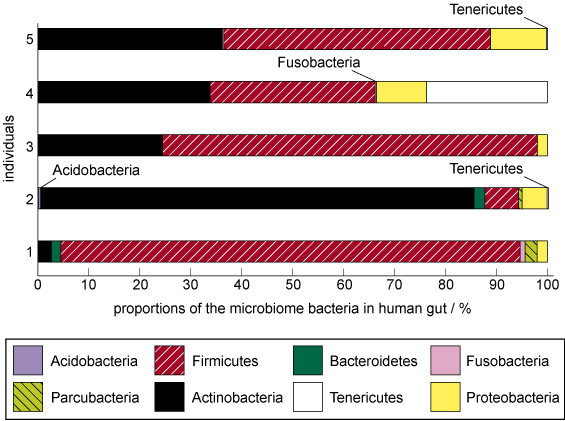1.2 Balancing the gut microbiome
The balance between the different bacterial groups within an individual’s enterotype is important in maintaining health, as is the balance between pathogenic and symbiotic bacteria of the microbiome. In fact, some microorganisms within the microbiota actually help to maintain this balance between pathogens and beneficial/harmless microbiota (working alongside the immune system) to avoid the development of disease.
In Figure 4, you saw that there is a different distribution of bacteria contained within the different microbiomes around the body. While this figure shows the typical distribution of bacteria, every human actually has a unique combination of microorganisms that form their microbiota. This can be seen in Figure 5, which shows the bacterial groups of the gut microbiota from five individuals.

-
Question 5
Based on the information in Figure 5, which individual has greater diversity in their gut microbiota, individual 1 or individual 3?
-
Individual 1 has 6 bacterial groups present in their gut microbiota. In contrast, individual 3 has three bacterial groups present in their gut microbiota. Based on the information in the figure, individual 1 has a more diverse gut microbiota.
Fun fact: gaseous by-products!
The unique microbiota profiles of each individual produce a unique combination of gases that are made as a by-product from the food that is consumed. As a result, each individual has a unique gas profile that can be measured. It is even thought that these gases may have important functions within the body, contribute to the development of diseases and might even be useful for the treatment of some conditions in the future! (Kalantar-Zadeh, 2019)
There are many factors which contribute to the microbiota profile of an individual. These include:
- genetic make-up
- exposure to microorganisms during pregnancy and early postnatal development
- geographical exposure to different environments
- diet
- exercise
- antibiotics, antimicrobials and other medications
- infection and disease
- age, including menopause.
Some factors, such as medications, menopause and disease, reduce the diversity of the organisms in the gut microbiota. Certain foods can also disrupt the normal balance of the bacterial species within the microbiota, while some other foods, pre/probiotics and exercise can improve the health of the microbiota, by promoting the growth of beneficial bacteria. All of these factors can have an impact on the health of the individual, and in the next section you are going to start to learn more about an unbalanced microbiome.
